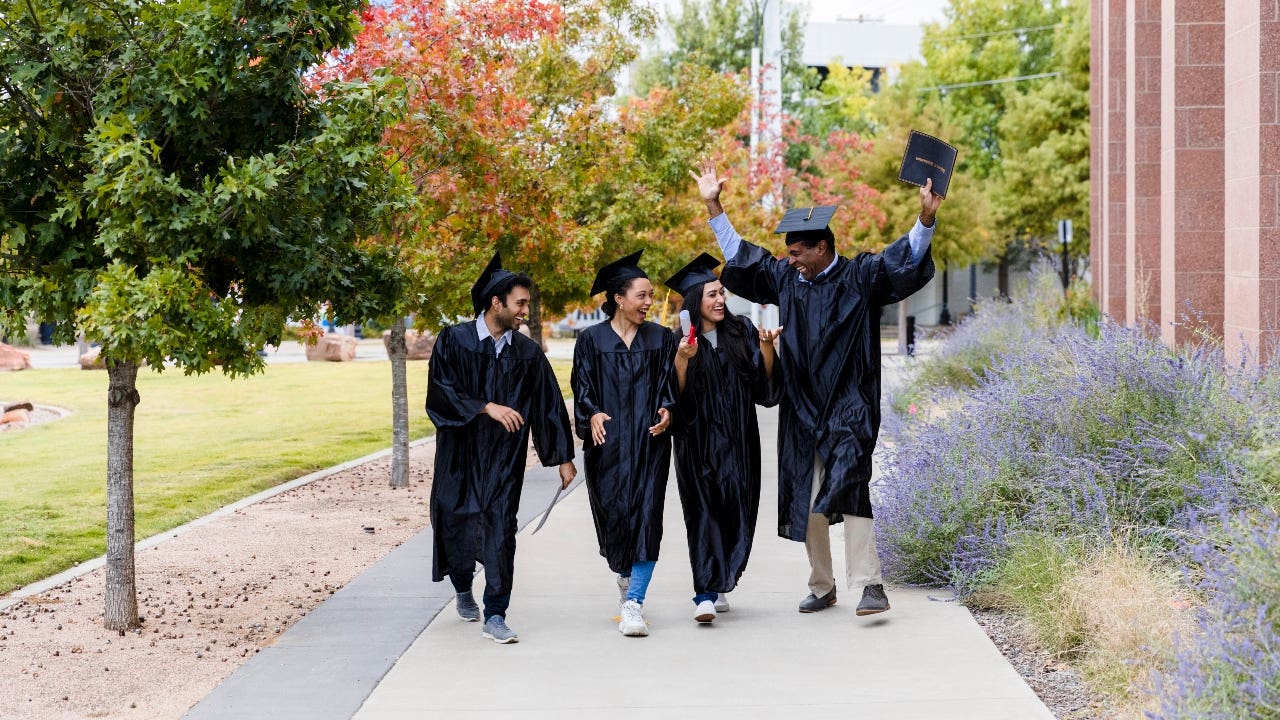What college graduation statistics tell us about higher education

The Bankrate promise
At Bankrate we strive to help you make smarter financial decisions. While we adhere to strict , this post may contain references to products from our partners. Here's an explanation for .
While the number of students enrolling in and completing a college degree program has steadily risen for generations, nearly half of students who enroll in a postsecondary education program do not graduate. The most recent data shows that, as of 2022, only 62.3 percent of undergraduate students in the U.S. completed their degree programs within six years of enrolling.
This six-year college completion rate has remained virtually stagnant since 2021, and the graduation rate is even lower for some demographics and within certain types of institutions. College dropout rates are also relatively high at 32.9 percent.
Financial concerns are a major barrier for students completing postsecondary degree programs, especially for those without great credit or from low-income backgrounds. Recent data shows that students with household incomes in the lowest quarter are 79.3 percent more likely to drop out than those in the highest quarter.
Even with federal financial aid and loan options, many have trouble qualifying for the aid they need, especially if they or their family have a low credit score. Bad credit loans are available for students who may have trouble qualifying for other student loans, but these loans tend to have higher rates. Ultimately, the best thing students from low-income backgrounds can do to avoid racking up massive debt in college is to fill out the FAFSA application and apply for as many grants as possible.
Key graduation rate statistics
- By 2022, 62.3 percent of students who started college full-time in 2016 earned a bachelor’s degree at that institution.
- Public colleges have an average graduation rate of 63 percent, and private nonprofit schools have a rate of 68 percent.
- Women are more likely than men to graduate within six years of starting their degree program.
- Roughly 42 percent of students graduate from public four-year schools without student debt, and 78 percent graduate with less than $30,000 in debt.
- In the 2021-2022 academic year, more than 2 million bachelor’s degrees were awarded in the U.S.
- Millennials are more likely to earn a bachelor’s degree than people from older generations.
- College enrollment and completion dropped significantly at the start of the COVID-19 pandemic, with postsecondary enrollment falling by 3.29 percent year over year.
- 64 percent of students pursuing a bachelor’s degree from a public institution have student loan debt
- 59 percent of adults in the U.S. who have had student loan debt for their own education say that this debt has caused them to put off other major financial decisions
- 51 percent of people who dropout of college drop out for financial reasons
- First generation college students have a 92.2 percent higher dropout rate than students whose parents completed a bachelor’s program or above
College dropout rates
College enrollment and completion rates went down significantly at the start of the pandemic, and while those rates have begun to stabilize, they are still lower than they were before the pandemic.
- Approximately 39 million people dropped out of college in 2020, and only 944,200 of those students re-enrolled the next fall.
- On average, 32.9 percent of students who enroll in an undergraduate degree program do not finish the program.
- 17 percent of students enrolled in college in May of 2022 planned to drop out after that semester.
- Among those students, 31 percent said they were dropping out to take advantage of the current job market.
- 29 percent of students from the same survey said that the rising cost of living was the primary reason they dropped out.
- Other top reasons students gave included not knowing what they want to study, mental and physical health issues, not being able to afford tuition and differences in college life since the pandemic.
While many factors could impact a student’s decision to drop out of college, financial concerns are a known barrier to completing degree programs. Students from low-income households are far more likely to drop out than students from high-income backgrounds. The financial barriers many face when trying to get a degree were intensified by the pandemic and resulting changes to the U.S. economy.
Average graduation rates
Graduation rates are typically defined as the percentage of students who graduate from a program within four or six years of starting at that institution. With that said graduation rates are seldom a perfect reflection of the total student population. For example, most measurements exclude part-time and transfer students.
The National Student Clearinghouse Research Center found that 62.3 percent of full-time students at all four-year institutions graduate within six years. However, that number is higher at private nonprofit institutions and lower at private for-profit and public institutions.
Undergraduate enrollment has sharply declined in recent years, especially due to COVID-19. Undergraduate enrollment for fall 2022 was 0.6 percent lower than for fall 2021.
Graduation rates by demographic
Graduation rates are not uniform for all student groups; rates differ across gender, age, race, etc. The demographic factors that impact college graduation the most are race/ethnicity and sex/gender.
Race/ethnicity
Race plays a significant role in educational attainment in the U.S., with white and Asian students far more likely to graduate within six years than Black and Hispanic students. The Hechinger Report points to financial pressure as a primary cause — structural inequities mean that Black and Hispanic students may need to hold a job while in college or attend expensive remedial classes to make up for inadequate high school preparation. This, combined with social pressures while on campus, could contribute to lower graduation rates for marginalized groups.
| Race/ethnicity | Graduation rate for full-time students within 4 years | Graduation rate for full-time students within 5 years | Graduation rate for full-time students within 6 years | Total full-time student graduation rate |
|---|---|---|---|---|
| Source: National Center for Education Statistics | ||||
| White | 45% | 15% | 4% | 64% |
| Black | 21% | 14% | 5% | 40% |
| Hispanic | 32% | 17% | 6% | 54% |
| Asian | 50% | 18% | 6% | 74% |
| Pacific Islander | 31% | 16% | 5% | 51% |
| American Indian/ Alaska Native | 23% | 12% | 4% | 39% |
| Two or more races | 39% | 16% | 4% | 60% |
Sex/gender
Data shows that men are much less likely to graduate within six years than women. This is true at every type of institution except private for-profit institutions, though the difference is greatest at private nonprofit institutions.
| Graduation rate within 6 years (all institutions) | Graduation rate within 6 years (public institutions) | Graduation rate within 6 years (private nonprofit institutions) | Graduation rate within 6 years (private for-profit institutions) | |
|---|---|---|---|---|
| Source: The National Center for Education Statistics | ||||
| Male | 60% | 60% | 64% | 31% |
| Female | 67% | 66% | 71% | 28% |
In addition to lower graduation rates, there is a steady decline of men enrolling in college, the Brookings Institute found. Those who identify as women may feel an added pressure to earn a degree to make up for lower pay or because of occupational segregation. While trade jobs — like construction or carpentry — often have competitive pay, some women may not feel that a job in majority-male workforce is as obtainable as other occupations that require degrees.
Graduation rates by school
Some colleges have higher graduation rates than others; for instance, students at Ivy League institutions are much more likely to graduate within six years than students at lesser-known public or for-profit schools. Here are the top 10 U.S. colleges with the highest and lowest graduation rates.
Colleges with the highest graduation rates
| College/university | Graduation rate | |
|---|---|---|
| Source: univstats.com | ||
| Princeton University | 98% | |
| Harvard University | 97% | |
| University of Notre Dame | 96% | |
| Yale University | 97% | |
| Columbia University in the City of New York | 97% | |
| University of Chicago | 96% | |
| Williams College | 94% | |
| Massachusetts Institute of Technology | 96% | |
| Duke University | 96% | |
Graduation rates by state
College graduation rates in the U.S. also vary by state. Rhode Island, Pennsylvania and Massachusetts hold the highest graduation rates, while New Mexico, Alabama, Wyoming and Arizona all have graduation rates below 40 percent.
States with the highest graduation rate
| State | Graduation rate |
|---|---|
| Source: univstats.com | |
| Rhode Island | 71% |
| Washington, D.C. | 63.54% |
| Pennsylvania | 61.74% |
| Massachusetts | 61.63% |
| Idaho | 61.04% |
States with the lowest graduation rate
| State | Graduation rate |
|---|---|
| Source: univstats.com | |
| New Mexico | 32.88% |
| Alaska | 37.5% |
| Alabama | 39.02% |
| Arkansas | 39.11% |
| Arizona | 40.32% |
Graduating with student loan debt
Almost 44 million Americans have outstanding student loan debt. Rising college tuition has meant that many students must take on debt for their education. The Peter G. Peterson Foundation found that after adjusting for inflation, federal student loan debt increased sevenfold from 1995 to 2017.
Data from the Association of Public and Land-Grant Universities shows that among those with student debt who received an undergraduate degree from a public four-year institution, the largest percentage of students graduated with debt of less than $20,000. However, the next-largest group of students graduated with more than $30,000 in debt.
| Student loan debt amount (bachelor’s degree from public 4-year institution) | Percentage of college graduates |
|---|---|
| Source: Association of Public and Land-Grant Universities | |
| $0 | 42% |
| $1–$19,999 | 23% |
| $20,000–$29,999 | 13% |
| $30,000–$49,999 | 15% |
| $50,000+ | 7% |
The good news for borrowers is that federal student loan payments and interest charges have stalled since March 2020 and will continue until October 2023. This has allowed many borrowers to pay down their balances without interest eating into those payments.
While borrowers are not required to make payments, the pause could help federal borrowers eliminate their student loan balances more quickly. Those with private student loans and are having trouble keeping up with payments amid rising interest rates should consider refinancing to achieve a lower interest rate and smaller monthly payments.
The bottom line
College students can increase their chances of graduating on time by working closely with their academic advisor, taking advantage of financial aid and choosing a field of study that interests them. And even though many students don’t graduate within the standard time frame for their program, a degree is still within reach — it’s possible to extend a degree program or even come back for a degree later on in life.
Related Articles




Nearly 80% of graduates with the 20 most lucrative college degrees are men